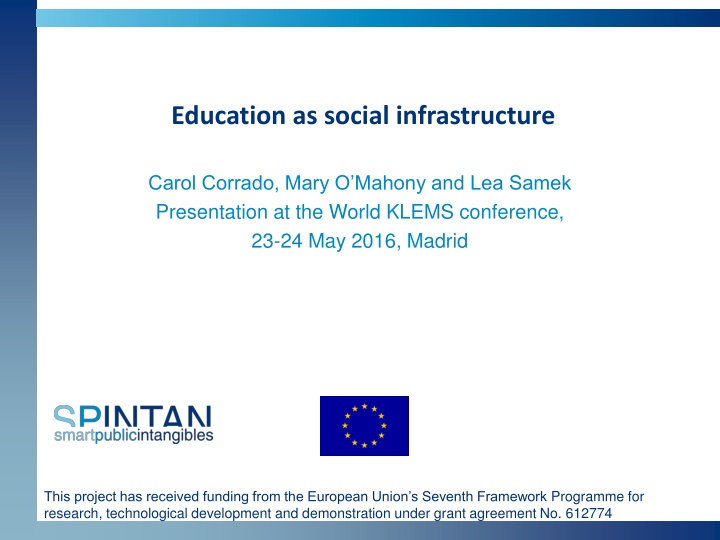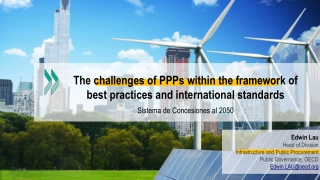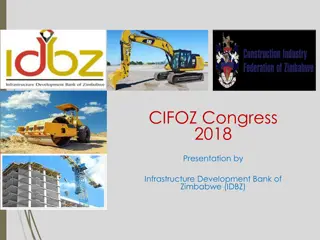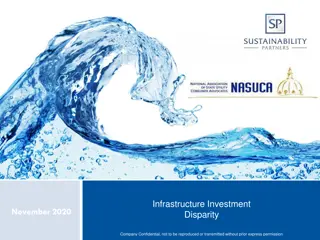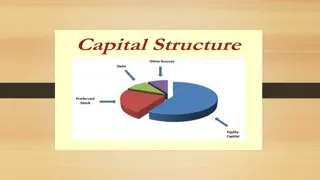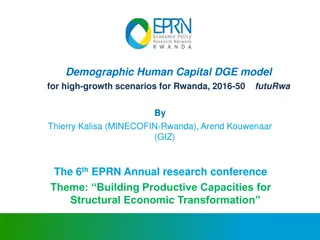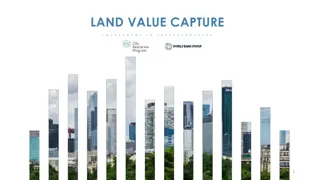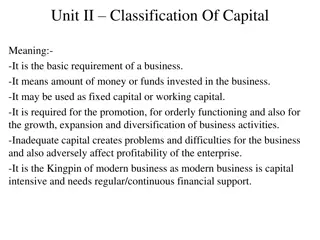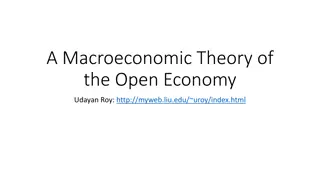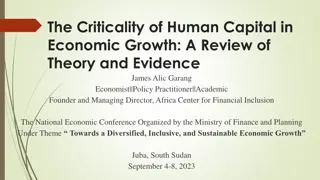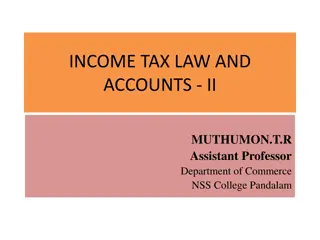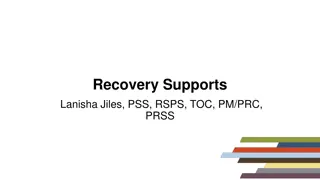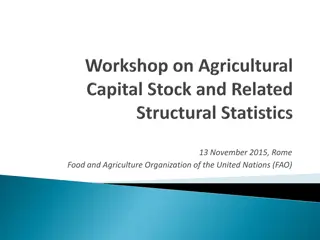Education as Social Infrastructure: Exploring Investment in Human Capital
This project delves into the concept of education services as a societal asset, linking it to the lifetime earnings approach. It discusses applying the Jorgenson-Fraumeni framework to measure investment in education services, addressing conceptual issues and presenting preliminary results. The model calculates lifetime incomes recursively based on age, sex, and education level, aiming to determine human capital values. Overall, the focus is on understanding the role of education in societal development.
Download Presentation

Please find below an Image/Link to download the presentation.
The content on the website is provided AS IS for your information and personal use only. It may not be sold, licensed, or shared on other websites without obtaining consent from the author.If you encounter any issues during the download, it is possible that the publisher has removed the file from their server.
You are allowed to download the files provided on this website for personal or commercial use, subject to the condition that they are used lawfully. All files are the property of their respective owners.
The content on the website is provided AS IS for your information and personal use only. It may not be sold, licensed, or shared on other websites without obtaining consent from the author.
E N D
Presentation Transcript
Education as social infrastructure Carol Corrado, Mary O Mahony and Lea Samek Presentation at the World KLEMS conference, 23-24 May 2016, Madrid This project has received funding from the European Union s Seventh Framework Programme for research, technological development and demonstration under grant agreement No. 612774
Motivation and Overview Starting point is Corrado, Haskel and Jona-Lasinio (2015) SPINTAN framework document This presentation concentrates on applying the Jorgenson Fraumeni framework to this model to measure investment in education services Discusses a number of conceptual issues Issues in applying the approach to UK data Some preliminary results with a health warning 2
Corrado, Haskel and Jona-Lasinio (2015) Sees education services as producing a societal asset Society's consumption of education services is the acquisition of schooling knowledge assets E whose change in value PES E should be included in saving and wealth Education services production is the schooling-produced increment to the beginning period knowledge stocks held by this years students. The idea is to link this to the lifetime earnings approach of Jorgenson and Fraumeni 3
The Jorgenson-Fraumeni framework Discussion based on Christian (2010) Calculates the values of human capital stocks based on lifetime incomes by sex (s), age (a) and education level (e). Let pop = population, y = current market income li = lifetime income = the discount rate g = average income growth senr = the enrolment rate sr = the survival rate. 4
The Jorgenson-Fraumeni framework The model calculates lifetime incomes recursively. First consider those above the age of education enrolment (35+). Assume market income is 0 beyond some age, say 80. For persons aged 80, lifetime income in year t is just current labour income. li , , 80 , = = y = , 80 , , s a e t s a e t For those aged 79, li is current labour market income plus discounted future income of those aged 80 with the same education and gender, conditional on survival: + 1 g = + li y sr y = = 80 = = , 79 , , , 79 , , , , , , 80 , , s a e t s a e t s a e t s a e t + 1 5
The Jorgenson-Fraumeni framework In general the lifetime income of those aged 35+ is given by: + 1 g = + | 35 li y sr li a , 1 + , 1 + , , , , , , , , , , s a e t s a e t s a e t s a e t + 1 This assumes that the best estimate of a person's income next year is that earned by a similar person this year who is one year older. 6
The Jorgenson-Fraumeni framework For persons aged between 5 and 34, lifetime income takes account of if they are enrolled in education or not. For these age groups: + 5 | 1 g = + + 1 ( ) 35 li y sr senr li senr li a , 1 + , 1 + , 1 + , 1 + , , , , , , , , , , , , , , , , , s a e t s a e t s a e t s a e t s a e t s a e t s a e t + 1 Their income depends on if they stay in education, in which case they earn li associated with education level e+1, or leave school and earn li associated with education level e. For those aged 0-4 the calculation is similar to those aged 35+ except current income is zero and their e is the lowest level. 7
The Jorgenson-Fraumeni framework The total value of the human capital stock in year t can be calculated by summing the lifetime earnings by s, a and e: = HC pop t i l , , , , , , t s a e s a e t s a e Christian (2010) defines net investment in human capital (NIH) as the effect of changes from year to year in the size and distribution of populations. This is given by: = ( i l ) NIH pop pop + , , , 1 , , , , , , t s a e t s a e t s a e t s a e This comprises various components including births, deaths, investment from education of persons enrolled in school and depreciation and aging of persons not enrolled in school. 8
Investment in Education The term corresponding to those enrolled in school which we use for nominal investment in education is given by: + 1 g s a e = enr ( ) ( ) NIH enr enr sr li + + + , , , 1 , , , , , 1 , , , 1 *, t s a e t s a e t s a e t s a e t + 1 Where enr are enrolments, and = + [ 1 ( ) ] li senr li senr li , 1 + , 1 + , 1 + , 1 + , 1 + , 1 + , *, , , , , , , , s a e t s a e t s a e t s a e t s a e t Which depends as before on if those enrolled stay on or leave education 9
Issues in calculating investment in education: Attribution Some part of lifetime earnings is a return to experience or employer provided training To capture the component arising from education we assumed income is constant at the earnings a few years after graduation. In that case the lifetime income stream only depends on how long the person is in the workforce after graduation. The calculations should also take account of the opportunity costs of staying in education beyond the age of compulsory education. Not included in the preliminary estimates We also do not take account of employment rates in this version but need to take into account 10
Growth in income and the discount rate Does the g that determines income growth include productivity and/or inflation gains. In other words, are nominal holding period gains to schooling part of the value of human capital This might be a capital gain in the national accounting sense as in: (????) = ??? ? + ???? The second term probably should not be included as per the usual exclusion of asset valuation changes from GDP. In this case it makes sense to set g=0. Should the discount rate be set equal to the SRTP as in Corrado and Jaeger (2015) In the estimates we assume g = 0.01 and use a 2% discount rate. 11
Education services and education costs What is the relationship between our nominal value of investment and expenditures on education? This could be a measure of effectiveness, i.e. ??? ? = ? ??????? where can be equal to, greater than, or less than one. If > 1 then could be a measure of quality. < 1 could be capturing penalty exacted from society due to resources of the school system not being used effectively. 12
Data Sources: UK estimates Enrolment rates from Education statistics Also need graduation rates UK Labour Force Survey and Annual Survey of Population were used to estimate earnings by age, gender and qualification level. faced many issues small sample sizes requiring regression based earnings estimates Problems with matching qualifications through time Life Tables for survival probabilities 13
Enrolments 14
Next Steps Deflators Apply model to the US data, and possibly a few large EU countries. 18
